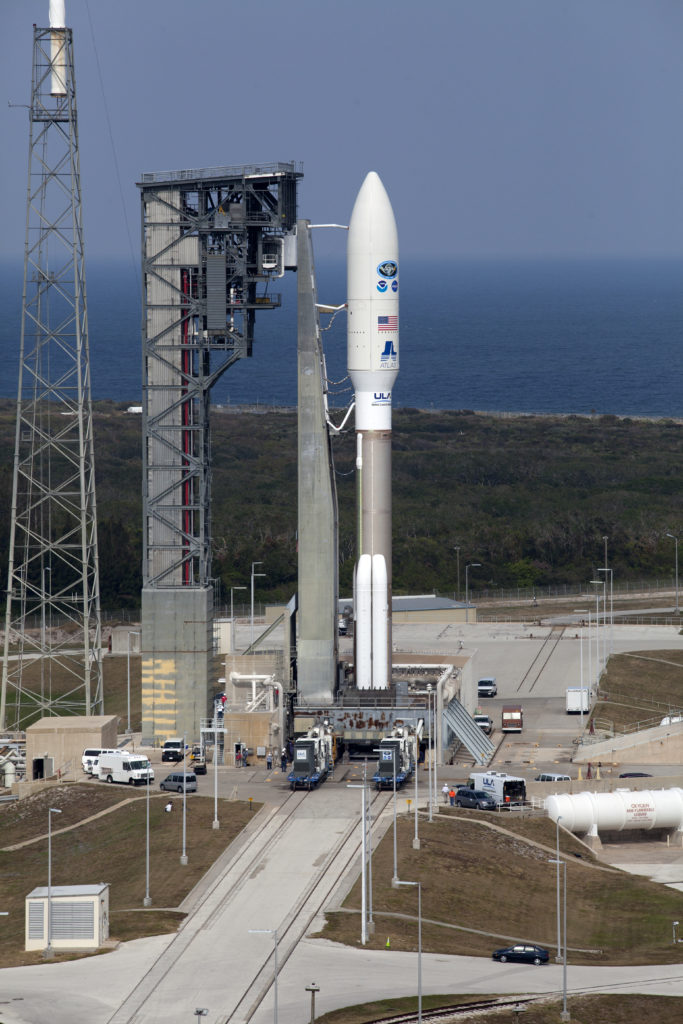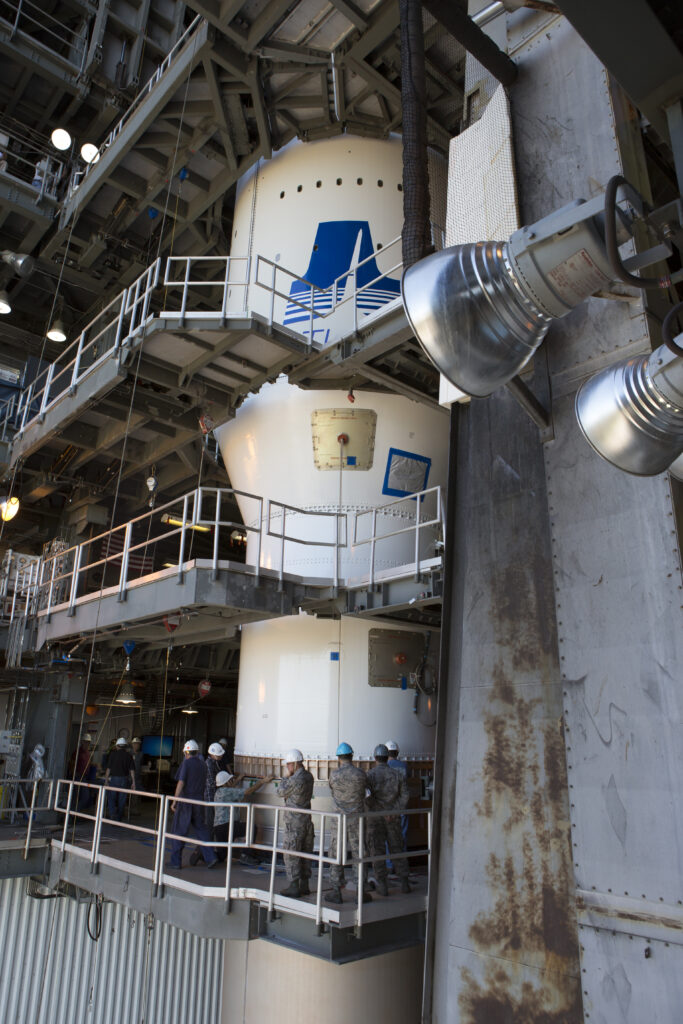The countdown has resumed as scheduled for the GOES-R launch today. Engineers are beginning the preparations to load cryogenic propellants into the Atlas V rocket.
Category: GOES-R
Go for Cryo Loading
The launch team completed its polls confirming they are reading to begin loading supercold propellants – known as cryogenics – into the Atlas V rocket and its Centaur upper stage. The countdown is in a planned hold at T-2 hours, but everything is on schedule for liftoff at 5:42 p.m. EST. The launch window extends for one hour today to begin the GOES-R mission.
Countdown Proceeding Smoothly – Forecast Improves

With less than three hours before the liftoff of the Atlas V rocket carrying the GOES-R satellite into orbit, the launch teams at Cape Canaveral, Florida, are working through a detailed timeline of tasks and checks to make everything goes smoothly. Today’s weather forecast improved to a 100 percent chance of acceptable conditions for launch. Liftoff remains on schedule for 5:42 p.m. EST.
Space Launch Complex 41 will be cleared shortly and the teams will perform steps to prepare to load the two-stage rocket with its cryogenic propellants. The first stage burns refined kerosene and liquid oxygen while the Centaur stage uses all-supercold propellants: liquid hydrogen fuel with liquid oxygen. The liquid oxygen is pumped into the rocket at minus-297 degrees, while the liquid hydrogen measures minus-423 degrees. The countdown, currently at T-2 hours, six minutes and counting, will enter a planned hold at the T-2 hour point.
Launch Day: Forecast Remains 90 Percent go

Good afternoon from Florida’s Space Coast! It is launch day for NOAA’s GOES-R satellite, the most sophisticated meteorological spacecraft of its kind, and the launch teams are proceeding toward an on-time liftoff at 5:42 p.m. EST from Space Launch Complex 41. A United Launch Alliance Atlas V rocket will launch the GOES-R satellite into geostationary orbit more than 22,000 miles above Earth. From there, the satellite will use its sensors to continuously track weather conditions, keep a watch on storms and even produce real-time maps of lightning activity.
You can keep track of the countdown, launch and ascent activities thoughout the afternoon and eveing here. NASA TV will cover the launch starting with a simulcast of a special prelaunch program carried by NASA EDGE starting at 3:45 p.m. on the NASA TV Media Channel. The program is live and featured on the NASA web and social media sites.
NASA TV’s launch coverage and commentary will be carried only on the NASA TV Media Channel beginning at 4:45 p.m. Following Soyuz docking coverage at about 5:06 p.m., launch coverage will switch to the NASA TV Public Channel. Coverage will conclude after spacecraft separation from the Centaur and the GOES-R solar arrays are deployed, which occurs about 3 ½ hours after launch. At that time the spacecraft initial state of health can be determined and will be confirmed on the air. There is no planned post-launch news conference. YOu can go to NASA TV’s coverage on the Web at https://www.nasa.gov/nasatv
Scenes From Today’s Rollout

The United Launch Alliance Atlas V rocket and its GOES-R payload were moved to the pad today as preparations continue for Saturday’s launch from Space Launch Complex 41.

The Atlas V is in its 541 configuration, which means it has the 5-meter-diameter payload fairing, four solid-fueled boosters and the Centaur upper stage is equipped with a single engine. Liftoff remains on schedule for 5:42 p.m. EST tomorrow.

Photo credit: NASA/Ben Smegelsky
Atlas V Rolled to Launch Pad
 The United Launch Alliance Atlas V rocket has been rolled to the launch pad at Space Launch Complex 41 and everything is progressing toward the launch of NOAA’s GOES-R spacecraft on Saturday at 5:42 p.m. EST.
The United Launch Alliance Atlas V rocket has been rolled to the launch pad at Space Launch Complex 41 and everything is progressing toward the launch of NOAA’s GOES-R spacecraft on Saturday at 5:42 p.m. EST.
Weather forecasters from the Air Force 45th Weather Squadron continue to call for a 90 percent chance of favorable weather for the one-hour launch window. For a closer look at the mission, watch the GOES-R webcast below.
GOES-R, a National Oceanic and Atmospheric Administration mission, is the first spacecraft in a new series of NASA-built advanced geostationary weather satellites. Once in geostationary orbit, GOES-R will be known as GOES-16 and will provide images of weather patterns and severe storms as regularly as every five minutes or as frequently as every 30 seconds. These images can be used to aid in weather forecasts, severe weather outlooks, watches and warnings, lightning conditions, maritime forecasts and aviation forecasts. It also will assist in longer term forecasting, such as in seasonal predictions and drought outlooks. In addition, space weather conditions will be monitored constantly, including the effects of solar flares to provide advance notice of potential communication and navigation disruptions. It also will assist researchers in understanding the interactions between land, oceans, the atmosphere and climate.
GOES-R Will Revolutionize Weather Forecasting

Take an in-depth look at the upcoming mission of NOAA’s GOES-R and the help it will provide to weather forecasters as they track everything from daily conditions to large hurricanes and other storms. The GOES-R spacecraft carries sensors far more advanced than those used now. Launch is scheduled for Saturday, Nov. 19, at 5:42 p.m. EST. A United Launch Alliance Atlas V rocket will lift the GOES-R satellite to an orbit more than 22,000 miles above Earth. From there, it will cast an unblinking eye on our planet.
Flight Readiness Review ‘Go’
 At the conclusion of a flight readiness review at Kennedy Space Center in Florida Tuesday, senior NASA and contractor managers voted unanimously to proceed with processing toward the targeted launch of the Geostationary Operational Environmental Satellite – R Series, or GOES-R, on a United Launch Alliance Atlas V rocket at 5:42 p.m. EST on Saturday, Nov. 19. A final “go” decision will be made at the GOES-R Launch Readiness Review on Thursday.
At the conclusion of a flight readiness review at Kennedy Space Center in Florida Tuesday, senior NASA and contractor managers voted unanimously to proceed with processing toward the targeted launch of the Geostationary Operational Environmental Satellite – R Series, or GOES-R, on a United Launch Alliance Atlas V rocket at 5:42 p.m. EST on Saturday, Nov. 19. A final “go” decision will be made at the GOES-R Launch Readiness Review on Thursday.
Weather forecasters from the U.S. Air Force 45th Weather Squadron are predicting an 80 percent chance of favorable weather for the one-hour launch window Saturday at Space Launch Complex 41 on Cape Canaveral Air Force Station in Florida.
GOES-R is the first spacecraft in a new series of NASA-built advanced geostationary weather satellites. Once in geostationary orbit, GOES-R will be known as GOES-16 and will provide images of weather patterns and severe storms as regularly as every five minutes or as frequently as every 30 seconds. These images can be used to aid in weather forecasts, severe weather outlooks, watches and warnings, lightning conditions, maritime forecasts and aviation forecasts. It also will assist in longer term forecasting, such as in seasonal predictions and drought outlooks. In addition, space weather conditions will be monitored constantly, including the effects of solar flares to provide advance notice of potential communication and navigation disruptions. It also will assist researchers in understanding the interactions between land, oceans, the atmosphere and climate. Photo credit: NASA/Ben Smegelsky
Launch Team Practices Countdown for GOES-R Liftoff

NASA, NOAA and United Launch Alliance controllers and engineers conducted a full dress rehearsal Monday for the launch of the GOES-R spacecraft later this week. The practice is standard for the launch team as it prepares for a mission. Working from consoles in facilities at Cape Canaveral Air Force Station, the teams ran through the same systems and processes they will use for the actual launch, which is set for Saturday at 5:42 p.m. EST. The launch window extends until 6:42 p.m. The weather forecast for Saturday calls for an 80 percent chance of acceptable conditions for launch.
The practice kicks off launch week which will include numerous activities leading up to the rollout of the Atlas V rocket to the pad at Space Launch Complex 41 and then to the launch itself. The GOES-R spacecraft, to be operated by NOAA once in orbit, will be the most advanced satellite of its kind. Equipped with specialized sensors, GOES-R will give forecasters better data, faster. That information will be used to enhance computer models and help meteorologists ultimately produce more sophisticated weather forecasts. For six reasons GOES-R matters, click here. Photo credit: NASA/Dan Casper
Engineers Prep to Encapsulate GOES-R for November Launch

 Processing engineers are set to encapsulate the GOES-R weather satellite into its payload fairing at the Astrotech payload processing facility near NASA’s Kennedy Space Center in Florida. The work is being performed as teams from NASA, United Launch Alliance and NOAA progress toward a liftoff on Nov. 16 from Space Launch Complex 41 aboard an Atlas V rocket. Launch time is 4:42 p.m. EDT.
Processing engineers are set to encapsulate the GOES-R weather satellite into its payload fairing at the Astrotech payload processing facility near NASA’s Kennedy Space Center in Florida. The work is being performed as teams from NASA, United Launch Alliance and NOAA progress toward a liftoff on Nov. 16 from Space Launch Complex 41 aboard an Atlas V rocket. Launch time is 4:42 p.m. EDT.
The spacecraft, folded into launch position, will be enclosed inside the two halves of the fairing before being taken to the launch pad and positioned atop the Atlas V. The fairing will protect the spacecraft during the climb through the lower atmosphere, then the two pieces will be jettisoned as the rocket pushes GOES-R toward its final orbit more than 22,000 miles above Earth. Once in orbit and operational, GOES-R will use its advanced instruments to help weather forecasters on Earth predict storms and atmospheric conditions and to track environmental changes. Photos credit: NASA/Dimitri Gerondidakis
